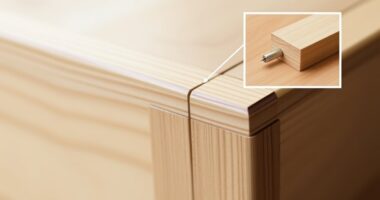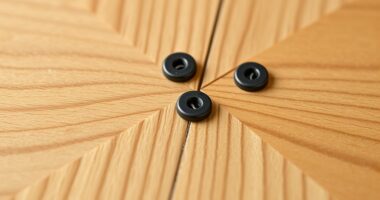Biscuit joinery is a handy technique for aligning flat panels accurately using oval-shaped, compressed wood plates. You mark where you want the biscuits, cut precise slots with a biscuit joiner, and then insert the biscuits with glue. As they swell, they tighten the panels, creating a flat, seamless surface. Proper tool maintenance guarantees clean cuts and strong joints. Keep exploring to discover tips for perfecting your biscuit joinery skills.
Key Takeaways
- Mark biscuit placement accurately to ensure even spacing and proper panel alignment.
- Use a biscuit joiner to cut precise slots matching the biscuit size for secure joints.
- Apply glue to biscuits before insertion to facilitate swelling and tight panel alignment during drying.
- Adjust the biscuit joiner settings regularly for accurate slot depth and positioning.
- Maintain and clean tools frequently to ensure consistent, clean cuts and optimal joint strength.

Biscuit joinery is a popular woodworking technique that allows you to create strong, precise, and seamless joints between pieces of wood. When you’re working on diy woodworking projects, it’s essential to understand how to use this method effectively, especially when aligning flat panels. Biscuit plates, or biscuits, are small, oval-shaped pieces of compressed wood that fit into matching slots cut into your project pieces. They help you align panels accurately and reinforce the joint, giving your work a professional finish. Properly using biscuit joinery can save you time and frustration, particularly when assembling large or complex projects.
To achieve great results, you need to guarantee your tools are in top shape. Regular tool maintenance is vital when working with biscuit joinery because dull or misaligned tools can cause inaccurate cuts, leading to weak joints or misaligned panels. Keep your biscuit joiner sharp and clean, and check that the blade is properly aligned. A well-maintained tool produces cleaner cuts, which fit together more seamlessly and hold together better. Remember, dull blades can also be dangerous, increasing the risk of kickback or uneven cuts. When you’re working on diy woodworking projects, taking time to clean and inspect your tools before each use will improve your accuracy and safety.
Regular tool maintenance ensures accurate cuts and safer, stronger biscuit joints for professional-looking woodworking projects.
Using biscuit joinery for flat panel alignment involves a few key steps. First, you need to mark where the biscuits will go, guaranteeing they’re evenly spaced and aligned across the joint. Then, you’ll use your biscuit joiner to cut precise slots into each panel. It’s important to adjust your tool’s settings to match the size of the biscuits you’re using, which helps maintain consistency and accuracy. After cutting the slots, you apply glue to the biscuit and insert it into one panel before joining it to the other piece. The biscuits swell slightly as they absorb the glue, tightening the joint and ensuring the panels stay perfectly aligned as the glue dries.
This process is especially helpful when working on wide panels or large surfaces where maintaining flatness can be challenging. Biscuit joinery provides a flat, flush surface without the need for clamps or additional filler, making it ideal for creating seamless, sturdy surfaces. Additionally, practicing good diy woodworking techniques, like proper tool maintenance, will guarantee your joints are tight and your panels stay flat. Over time, you’ll develop a sense of how to best position your biscuits and adjust your tools for peak results. By investing a little effort into maintaining your tools and precision in your cuts, you’ll find that biscuit joinery becomes an efficient and reliable method for flat panel alignment in all your woodworking projects.
Frequently Asked Questions
What Types of Wood Are Best for Biscuit Joinery?
You should choose hardwoods like oak, maple, or cherry for biscuit joinery, as they have stable moisture content and consistent wood grain patterns. These qualities guarantee strong, durable joints, and reduce the risk of warping or splitting over time. Avoid softwoods with high moisture content or irregular grain, since they can compromise the joint’s strength and stability. Properly selecting and preparing your wood assures a successful, long-lasting connection.
How Do I Adjust Biscuit Plate Positioning for Uneven Surfaces?
To adjust biscuit plate positioning for surface unevenness, start by loosening the plate clamps and manually aligning the plates to match the surface contours. Use a straightedge or level to check surface flatness, then fine-tune the plate alignment accordingly. Tighten the clamps securely once the surface unevenness is compensated for, ensuring the plates hold the correct position for precise biscuit joinery.
Can Biscuit Joinery Be Used for Load-Bearing Furniture?
Biscuit joinery can be used for load-bearing furniture, but it has limitations. You need to take into account load-bearing capacity and proper joint placement. For heavier loads, reinforce with additional fasteners or stronger joinery methods. Keep in mind that biscuit joints are more suitable for alignment and secondary support, so don’t rely solely on them for critical, load-bearing structures. Proper planning ensures durability while respecting biscuit joinery limitations.
What Safety Precautions Should I Take When Using a Biscuit Joiner?
Ever wondered how to stay safe with a biscuit joiner? Always wear safety gear like goggles and ear protection to guard against debris and noise. Keep your workspace clean and make certain the tool is well-maintained before use. Use both hands to steady the joiner and avoid loose clothing. Are you ready to cut safely? Remember, proper safety precautions protect you and ensure your project turns out perfectly.
How Do I Repair a Misaligned Biscuit Joint?
To repair a misaligned biscuit joint, first carefully disassemble the joint without damaging the wood. Then, clean out any excess glue or debris. For a biscuit joint fix, reapply glue, align the panels precisely, and insert a new biscuit if needed. Clamp the pieces firmly until the glue sets. This ensures your biscuit joint repair is strong and properly aligned, restoring the panel’s stability.
Conclusion
Using plates for biscuit joinery is like giving your project a sturdy backbone, ensuring perfect alignment every time. With this simple technique, you’ll find your panels fit together as smoothly as a well-choreographed dance. Don’t underestimate the power of these small plates—they’re the unsung heroes that make your craftsmanship shine. Embrace this method, and watch your flat panels come together with confidence, turning your woodworking dreams into a solid, seamless reality.









